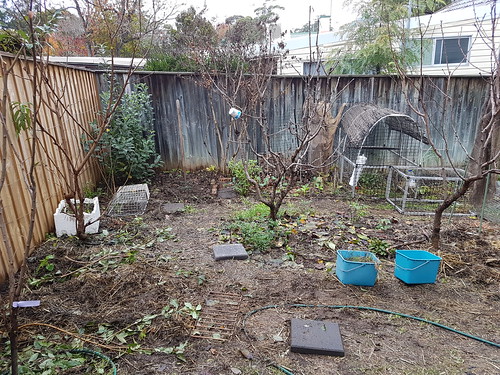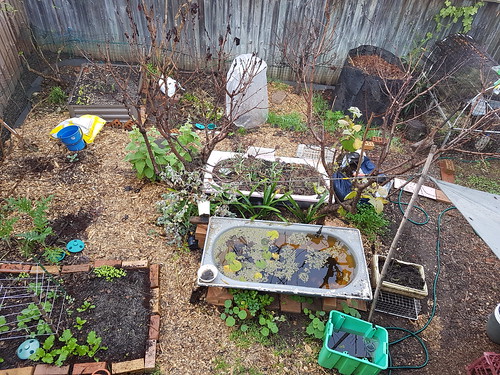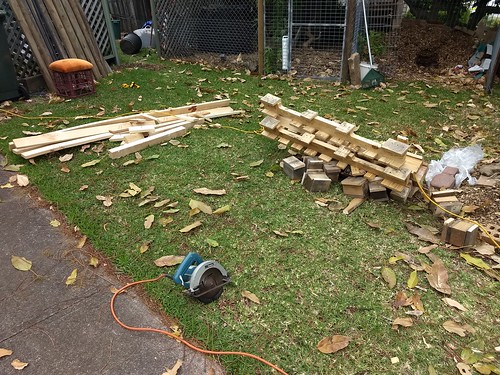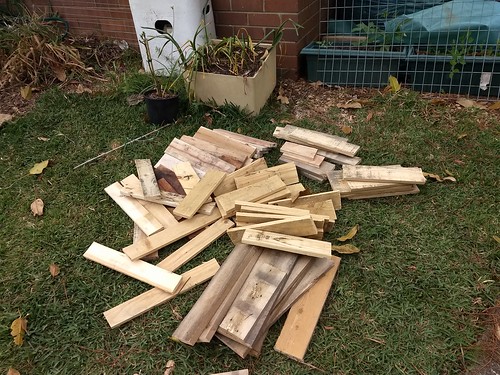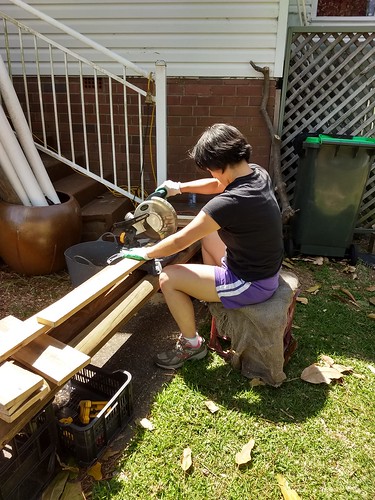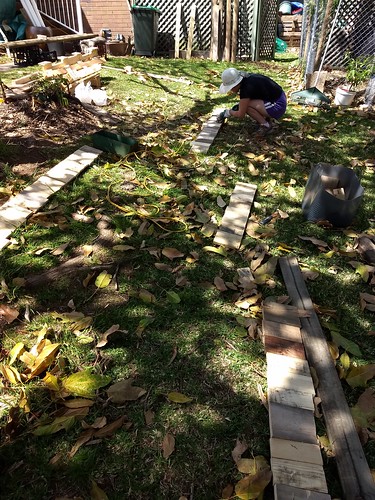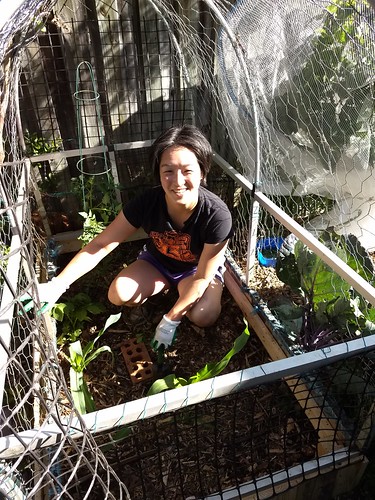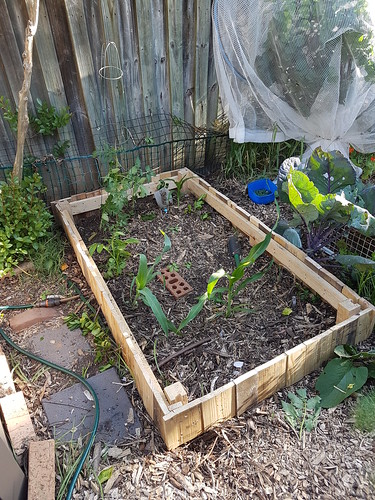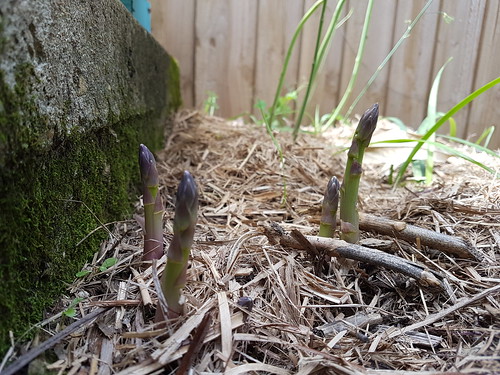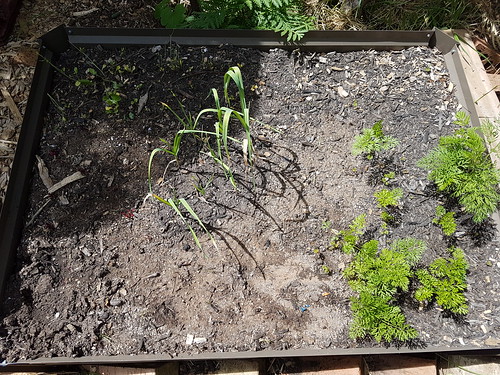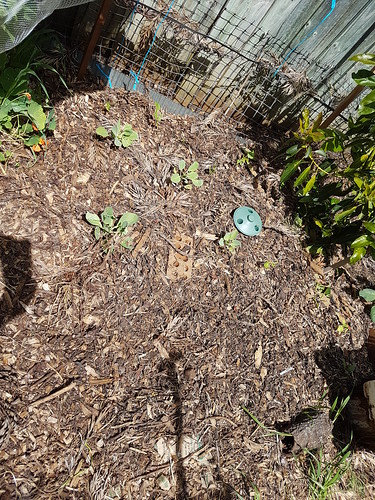Iteration One - February 2019
The first iteration of the Johnson-Su compost bioreactor was made in December 2018, during a permabee at my house
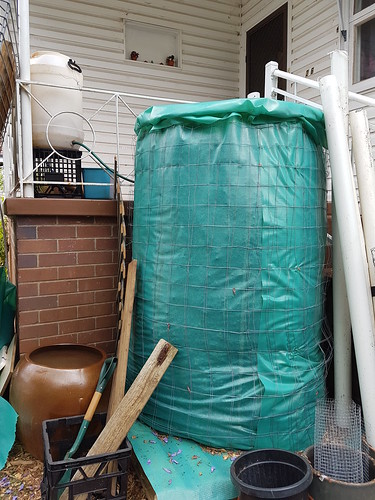
There were a few variations in the way we built this:
1. The wire was thinner than it was in the video - maybe 4-gauge, while the video wire was about 6-gauge or something?
2. The plastic was green and translucent rather than black, which may have made a difference to the bio-organisms that are supposed to be occupying the compost: they may not like the light, so the outside may end up not quite as well-processed as the inside.
3. The woodchips were actual woodchips, minimum 2.5cm (1 inch) and many were rather larger.
Otherwise we built the compost bioreactor according to the specifications in this video and left it be.
I don't think there was quite enough nitrogen materials for the bioreactor, because it didn't heat up at all. I had to add coffee and horseshit to the top of it and it's not really soaked all the way through. Next time, I'll spend a couple of weeks building up the nitrogenous materials: coffee, lawn clippings, horseshit, vege refuse from the local greengrocer...
Anyway, the compost didn't hot-decompose at the start, but so far as I can tell from turning it over, it's still decomposing fairly well with a regular application of runoff wash water (sometimes mixed with human urine). It's only been 3 months, though, so it's difficult to be sure - I think you're supposed to leave it for 5-6 months at least.
Iteration Two - July 2019
I'm writing this in October 2019, 2 months ago after I had another permabee, during which we took apart the Johnson-Su bioreactor.

There was some decomposed material, but not the entirety of the bioreactor as expected from the video. The compost was filled with undecomposed woodchips. This was disappointing to say the least.
So we sifted some of the composted matter out and rebuilt the bioreactor, chipping up the larger pieces of wood and branch the better to decompose.
It seems to be decomposing a little faster than last time; it's been two months and it has a fairly significant slump to it, which suggests it's processing. The 'lid' has blown off - we've had some strong winds in late winter and early spring, and when it rains (as it occasionally does here) the lid fills with water that then needs to be redirected either back into the compost or into the garden.
The wooden pallet beneath the biocomposter has collapsed. It held up for the first biocompost, and then through the making of the second, but it's given up the ghost, and the biocompost is leaning rather heavily. The plastic underneath the biocomposter is very necessary to keep the pallet from rotting since the materials are being regularly dampened.
Speaking of which, a bucket a day into the water reservoir over the biocomposter, seeping down through the tubing that I put there, seems to be working pretty well. It's a manual labour that's a little frustrating, but not terrible now that spring is in and it's not freezing cold outside in the mornings.
I have recently added some 'duck straw' - straw that has been used for keeping ducks - whole and unchopped, and now I'm regretting that, just a little. I should have run it over with the mower a few times and worked from there.
several thoughts
The first video didn't really specify the size of the woodchips - it just said 'woodchips' which I've since discovered means something else in the USA to what it means here in Australia (Wood Chip Gardening: What I Wish I Knew When I First Started). The second video by Johnson on filling the bioreactor specified the size - 3/4 inch (1.75cm) size - and noted that he pretty much chopped up the leaves using either a leaf mulcher or a lawnmower.
The size of the pieces in the biocomposter is going to make a big difference, I feel. As with any compost, when you're making it, you want things to be damp and chopped up into small pieces.
Going forward
At this point, I'm not sure that making it a third time would be terribly helpful: while the plastic is still okay to go, the wire is falling apart and probably best suited as a climbing frame for something light - beans or peas, perhaps. Also, the pallet underneath would need replacing. I guess it's a different kind of compost to the hot compost in the composting bays, or the stuff that I make in the black geobins.
Ultimately, the value of the biocompost is in the high volume of microbial-organisms that take up residence in the decomposing compost due to not being regularly turned the way a 'hot' compost would be turned. Also, not having to turn the compost - a big attractant given how many composts I have that require regular turning over!
I probably wouldn't want to make it more than once a year; let it sit for six months, gather up the materials for the other six months, breaking them down, then making the compost and letting it sit.
Hm. I'm also wondering if I could make the biocompost using a geobin structure for the framework.


